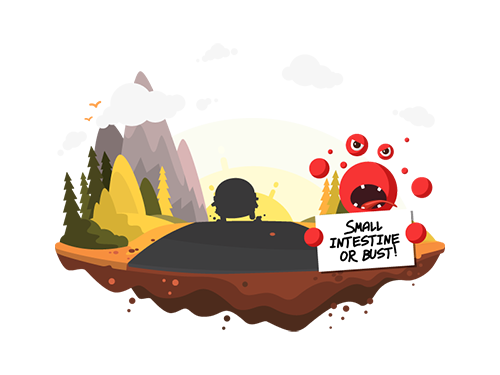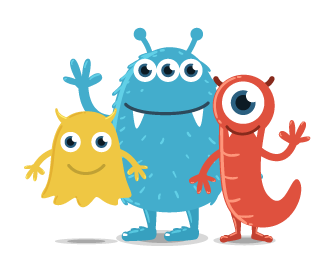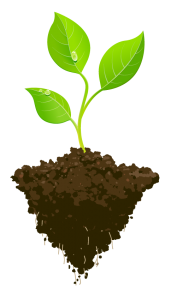Microbiology
You don’t have to be a microbiologist or scientist to work in a kitchen or restaurant, but basic knowledge of will help you to understand why there are regulations for handling food. are so tiny that they can only be seen with a microscope. They are everywhere: on our bodies, on animals, in water, soil and air. Fortunately, 99% of all microbes are harmless or even beneficial. However, one percent of microbes can cause severe illness and death. We will concentrate on the disease-causing microbes that can be carried by food.
In this module, we will explore two topics:
- Microbes
- Bacterial microbes
Learning Objectives
When you have completed this module, you will be able to:
- Recognize the 4 types of and their role in food .
- Identify the role of in causing food poisoning.
- Recognize common disease-causing , the conditions in which they multiply and how they can be a danger to the food service industry.
Self Test
Use the Self Test to discover what you already know about the topics covered in this module. That way, you can focus on the topics you are not familiar with.
If you do not feel ready for the Self Test yet, move on to the rest of the module. You may return any time by clicking on the Menu at the top of this page.
Microbes
Microbiology is the study of very small (microscopic) living known as or . These organisms are so tiny that they can only be seen with a microscope.
There are almost as many myths and misconceptions about microbiology as there are micro-organisms! The following exercise, Germ Conquest, will provide an overview of the topics covered in this module.
Germ Conquest
Question: All microbes cause disease.
99% of all microbes are harmless to us or are beneficial to us.
Not all microbes cause disease. 99% of all bacteria are harmless to us or are beneficial to us.
Question: Bacteria need water and sunlight to reproduce.
While bacteria do need water to reproduce, they do not need sunlight.
Bacteria do need water to multiple but they do not need sunlight.
Question: Bacteria reproduce most rapidly between 4 – 60°C (40 – 140°F).
Bacteria reproduce most rapidly between these temperatures. This temperature range is called the Temperature Danger Zone.
Bacteria reproduce most rapidly between these temperatures. This temperature range is called the Temperature Danger Zone.
Question: Insects play no part in transmitting microbes.
Many insects can transmit microbes that cause diseases to people and animals; examples are Lyme Disease from ticks and Malaria from mosquitoes.
Many insects can transmit microbes that cause diseases to people and animals; examples are Lyme Disease from ticks and Malaria from mosquitoes.
Question: The Hepatitis virus can be spread by food.
One type of Hepatitis virus that causes food poisoning can be spread to people from uncooked foods.
One type of Hepatitis virus that causes food poisoning can be spread to people from uncooked foods.
Germ Conquest
Question: Under ideal conditions, bacteria can multiply to more than one million in a 24-hour period.
If bacteria have everything they need to multiply they can grow very quickly.
If bacteria have everything they need to multiply they can grow very quickly.
Question: Sanitizing kills all microbes.
Sanitizing kills most microbes. When you sanitize dishes, you reduce the number of bacteria and spores to a safe level which will not cause people to become ill. The only way to make things completely microbe-free (germ-free) is to sterilize; sterilizing can only be done with special equipment found in hospitals and dental offices.
Sanitizing kills most microbes. When you sanitize dishes, you reduce the number of bacteria and spores to a safe level which will not cause people to become ill. The only way to make things completely microbe-free (germ-free) is to sterilize; sterilizing can only be done with special equipment found in hospitals and dental offices.
Question: Lemon makes food more acidic.
Lemon is acidic and can make food it is added to more acidic.
Lemon is acidic and can make food it is added to more acidic.
Question: Gravy should be slowly reheated in the steam table.
Gravy should be reheated quickly using a stove. Steam tables are not designed for reheating food; they are designed to keep hot food at a high enough temperature that micro-organisms cannot grow.
Gravy should be reheated quickly using a stove. Steam tables are not designed for reheating food; they are designed to keep hot food at a high enough temperature that micro-organisms cannot grow.
Question: A pathogen is a disease-causing microbe.
Microbes that can cause diseases are called “pathogens”.
Microbes that can cause diseases are called “pathogens”.
Microbes - Types
The different types of include: bacteria, viruses, fungi, parasites and protozoa.
 Bacteria
Bacteria
Bacteria are very small, single-celled organisms that can only be seen with a microscope . There are thousands of species, which can be found in just about every material and environment. Most bacteria are harmless. E. coli O157:H7 is an example of a strain of bacteria that can make you sick.
 Fungi
Fungi
Fungi are living organisms that are neither animals nor plants and include moulds and yeasts. Aspergillus mould is an example of a harmful fungus. It produces toxins that can cause cancer. This mould can be found in nuts, grains, and the milk of cows that were fed mouldy grains.
 Parasites & Protozoa
Parasites & Protozoa
Parasites live on or in humans and use them to grow. People can get them from contaminated water, eating under-cooked meat from a contaminated animal or cross-contamination.
Trichinosis is a type of parasitic infection that can spread through raw or under-cooked pork or wild game.
Protozoa are a type of parasite. They live in the digestive tract of people and animals and can cause foodborne illness. They get into food from contaminated water. Giardiasis, also known as Beaver Fever, and Cryptosporidiosis are examples of foodborne illness called by protozoa.
 Viruses
Viruses
Viruses are smaller than bacteria and cannot live on their own. Viruses need a host to survive. They get inside the cells of the host and take it over. Hepatitis A is a virus that can spread to humans through contaminated food and water and make them sick.
Microbes - How Microbes Travel
 All four types of are found throughout our environment in soil, dust, water and air. They are also in and on humans, animals, birds, fish and insects.
All four types of are found throughout our environment in soil, dust, water and air. They are also in and on humans, animals, birds, fish and insects.
Microbes cannot walk, crawl or fly on their own. They get from place to place when someone or something moves them. You could say they are experts in hitchhiking; they move from place to place by attaching themselves to people, insects, and rodents. Microbes are dropped off as people, insects and rodents touch other surfaces and food. Microbes can also end up in the air and move around in the wind.
Let’s look more closely at one of those “rides”!
Microbes - How Microbes Travel
 Flies don’t look harmful, do they? Well, in fact they are worse than cockroaches for the ease with which they can carry . Think about where flies hang out. They are often found on dead animals, , and garbage. Microbes attach themselves to the tiny hairs on the fly’s body and mouth parts and are carried to wherever the fly lands.
Flies don’t look harmful, do they? Well, in fact they are worse than cockroaches for the ease with which they can carry . Think about where flies hang out. They are often found on dead animals, , and garbage. Microbes attach themselves to the tiny hairs on the fly’s body and mouth parts and are carried to wherever the fly lands.
This is something to keep in mind the next time you see a fly. You never know where it was hanging out before it landed on your food!
Did you know?
Flies cannot eat solid food, so to soften it up, they vomit on it. Then they stomp the vomit in until the food turns into a liquid, usually stomping in a few microbes for good measure. Then, when their food is good and runny, they suck it in, probably dropping some at the same time. When they have finished eating, it’s your turn.
Microbes - Beneficial Microbes
 Not all are harmful. In fact, 99% of all microbes are harmless and may even be beneficial. Can you think of any examples of products or processes in which microbes play an important or beneficial role?
Not all are harmful. In fact, 99% of all microbes are harmless and may even be beneficial. Can you think of any examples of products or processes in which microbes play an important or beneficial role?
There are 7 examples on the next screen. Try to come up with at least two, before you look.
Microbes - Beneficial Microbes
You know now that there are many more good than bad. Here are some examples of processes in which microbes play a beneficial role:
- Bread making – Bread dough rises with the help of .
- Wine making – are used to ferment the grape juices into wine.
- Cheese making – Bacteria are used to ferment the milk. Some cheeses (like blue cheese) have in them.
- Dairy industry – Bacteria are found in yogurt and sour cream.
- Medicines – Penicillin is made from mould.
- Digestion – Bacteria in our intestines help us digest food.
- Breaking down waste – Bacteria break down waste in septic tanks.
So who are the bad guys?
Microbes - Pathogens
The 1% of that can make us sick are called . There are some bacteria, some viruses and some fungi that can cause disease.
Most people don’t know the term “pathogens” and refer to them as ““. Pathogens are germs that cause illness in people. We’ll try to use the term “pathogen”.
Pathogens are found on the skin and in the , , urine, blood and other body fluids of people or animals, and also in the environment.
Did you know?
is similar to a tiny plant, with root-like and stem-like structures, and a flower-like top. As mould grows and matures, it sheds (like the seeds of a dandelion flower), which are dispersed into the air until they land on something that they can grow in.
As moulds grow, they produce poisons () that can make people sick if they eat them. This is why you must discard any food that has signs of mould growth.
Microbes - Pathogens
There are many bacterial pathogens that cause foodborne illness. The following chart lists some examples:
| Bacteria | Source | Interesting to know |
|---|---|---|
| Salmonella (2000 species) | Poultry and raw eggs | You will learn more about it in the Foodborne Illness Module |
| E. coli 0157:H7 “hamburger disease” | Cattle intestines | Can cause bloody diarrhea and kidney failure |
| Staphylococcus aureus | Found on the human body: noses, infected cuts/eyes and pimples | Forms a toxin in food that can’t be destroyed by cooking. See the Foodborne Illness Module |
| Clostridium perfringens | Soil | Found on vegetables, cereals, raw meats, and poultry |
| Bacillus cereus | Soil | Found in rice, vegetables, cooked meat and custards. This is a spore-forming bacteria |
| Campylobacter jejuni | Poultry and cattle intestines | Prevention: proper cooking, cleaning and handwashing |
| Vibrio parahaemolyticus | Grows in silt (soil) in coastal waters where raw fish and shellfish are harvested | It is not recommended to eat raw seafood (exceptions are sushi-grade fish and seafood) |
| Listeria monocytogenes | Luncheon meats (cold cuts), soft cheese | Grows well at refrigeration temperatures; can cause miscarriage in pregnant women |
What does that mean to you as an employee in the food industry or in your home?
Microbes - Pathogens
As a food handler, your hands come into contact with raw and cooked foods. That means you risk the food of others. You can help to reduce the spread of by washing your hands frequently and ensuring you have no open cuts or wounds that may jeopardize the safety of the food you serve.
Remember: Pathogens cannot be detected in food by smell or taste. Reduce the risk of pathogens in the food by following the safe food handling principles and practices you will learn in this course.
The next few screens will give you a chance to practice what you have learned about pathogens.
Microbes - Exercises
Not all of the following statements about are correct.
Select the TRUE statements about viruses:
Microbes - Exercises
Select the TRUE statements about :
Remember! It is important to discard any food showing signs of mold and yeast growth.
Microbes - Exercises
Select the TRUE statements about :
Microbes - Exercises
Select the TRUE statements about parasites, including protozoa:
Bacterial Microbes
 We’ll begin this section by looking at in more detail.
We’ll begin this section by looking at in more detail.
Under the right conditions, bacteria divide in 2 every 20 minutes. One bacterium can turn into billions within a 24-hour time period.
What conditions do bacteria need in order to grow?
Bacterial Microbes - FATTOM
There are six factors that affect the growth of . You can remember the six factors more easily if you remember the first letter of each: . Just think of ‘Fat Tom’, a chef who likes to taste his food!
In the next few slides you will learn about each of the following:
- Food
- Acidity
- Time
- Temperature
- Oxygen
- Moisture
Bacterial Microbes - FATTOM
Food
Bacteria are living organisms that need food. They grow best in food that is moist and high in protein. These foods are considered high-risk foods. Here are some examples:
- milk and milk products
- sliced melons
- garlic-and-oil mixture
- poultry: chicken, turkey
- meat: beef, pork, lamb and veal
- fish and seafood
- sprouts
- eggs
- soy products (like tofu)
- cooked rice, beans, grains, vegetables and potatoes
- mayonnaise-based salads (like egg, potato and tuna salad)
Bacterial Microbes - FATTOM
Acidity
pH is a measurement of acidity and alkalinity in food. The amount of acidity or alkalinity can be measured with a pH meter. pH scale ranges from 0 to 14.
As you can see from the scale below, foods such as fruit and vinegar are acidic in the 0 to 4.5 range. Although some bacteria can survive in acidic foods, they don’t grow in highly acidic conditions.
Foods such as meat, dairy and even melons are considered to be weakly acidic or neutral, in the 4.5 to 7 range. This is the type of environment bacteria grow very well in.
Foods such as egg whites and soda crackers are alkaline, in the range from 8 to 14. These alkaline foods will not support the growth of bacteria.

Bacterial Microbes - FATTOM
Time
High-risk foods should spend as little time as possible in the Temperature Danger Zone (TDZ); no more than 2 hours. The 2-hour rule gives a good safety margin since you may not know the details of what happened to the food before, during or after the delivery.
Bacterial Microbes - FATTOM
Temperature
The Temperature Danger Zone (TDZ) is the range from 4°C (40°F) to 60°C (140°F). Bacteria grow and multiply quickly in food that is kept in the TDZ.
When you handle food, it is important that high-risk foods spend as little time in this temperature range as possible.
High-risk foods should not be in the Temperature Danger Zone (TDZ) for more than 2 hours. The next few modules will provide more information on the TDZ.
Keeping food in the refrigerator keeps it out of the TDZ, but this only slows down bacterial growth. Bacteria do not stop growing in the fridge!
Holding food above 60°C (140°F) will stop bacteria from growing and will even kill some.
High cooking temperatures will kill bacteria.
Bacterial Microbes - FATTOM
Oxygen
Some bacteria will only grow where there is oxygen present. They are called aerobic bacteria.
Other bacteria will only grow where there is no oxygen present and are called anaerobic bacteria.
Foodborne illness can be caused by either type; aerobic or anaerobic.
Bacterial Microbes - FATTOM
Moisture
Water activity is a way of measuring the amount of moisture in a food.
Bacteria need water to grow. They will survive in foods that do not have a lot of moisture, but will not grow.
For example, salmonella bacteria survive on an eggshell but they don’t multiply there because of lack of moisture.
Bacterial Microbes - Exercises
Now that you know what bacteria need to multiply, see if you can figure out which of the foods in the following screens have the greatest risk of bacterial growth.
In order to control in foods, it is important to understand the conditions that bacteria need to grow and multiply. The following exercise demonstrates these conditions. On each page, you will find 2 images of food with a description.
Select which of the two foods has the greatest risk of bacterial growth.
Hard Cheese
Sorry.
A hard cheese like Parmesan is safer than soft cheese like Ricotta, because there is less moisture available for bacteria to grow.
Soft Cheese
Correct!
Soft cheese like Ricotta is more dangerous than hard cheese like Parmesan because there is more moisture available for bacteria to grow.
Bacterial Microbes - Exercises
Select which type of food has the greatest risk of bacterial growth.
Chicken
Correct!
Poultry is more dangerous because it is high in protein and moisture. Chocolate cake is safer because most chocolate cakes don’t have a high protein or moisture content.
Chocolate Cake
Sorry.
Chocolate cake is safer because most chocolate cakes don’t have a high protein or moisture content. Poultry is more dangerous because it is high in protein and moisture.
Bacterial Microbes - Exercises
Select which type of food has the greatest risk of bacterial growth.
Jarred Pickles
Sorry.
Jarred pickles are safer because the pH is too low to support bacterial growth. Whipping cream is more dangerous because of its moisture and protein levels.
Whipping Cream
Correct!
Whipping cream is more dangerous because of its moisture and protein levels. Jarred pickles are safer because the pH is too low to support bacterial growth.
Bacterial Microbes - Exercises
Select which type of food has the greatest risk of bacterial growth.
Homemade garlic in oil
Correct!
Homemade garlic in oil is more dangerous because no oxygen is present around the garlic. This creates a great environment for spore-forming bacteria and can result in botulism. A spray bottle with vegetable oil is safer because it is purchased from a store. Learn more about this in the next section on spore-forming bacteria.
Spray bottle with vegetable oil
Sorry.
A spray bottle with vegetable oil is safer because it is purchased from a store. Homemade garlic in oil is more dangerous because no oxygen is present around the garlic. This creates a great environment for spore-forming bacteria and can result in botulism. Learn more about this in the next section on spore-forming bacteria.
Bacterial Microbes - Exercises
Select which type of food has the greatest risk of bacterial growth.
Bananas
Sorry.
Melons are more dangerous than other fresh fruit because bacteria, such as Salmonella, have been found on the outer skin. When the melon is sliced, the bacteria are dragged to the inside by the knife and are able to survive in the fruit because it is not acidic like most other fruits are. Bacteria do not normally live or grow in acidic environments.
Melons
Correct!
Melons are more dangerous than other fresh fruit. Pathogens such as Salmonella have been found on the outside surface of melons. When the melon is sliced, the bacteria are dragged to the inside with the knife. The flesh of melons, unlike other fruits, is not acidic, so pathogens are able to live and grow.
Bacterial Microbes - Exercises
Select which type of food has the greatest risk of bacterial growth.
Cooked Meatballs Holding temp; 60°C/140°F
Sorry.
Cooked meatballs kept at an internal temperature of 60°C (140°F) are safer than raw ground beef, because bacteria cannot grow above 60°C. Raw meat may naturally contain bacteria; this is why proper cooking is important. Refrigeration temperatures of 4°C (40°F) only slow the growth of those bacteria. Raw ground beef has everything else bacteria need to grow, like neutral pH, protein and moisture.
Raw Ground Beef Fridge temp; 4°C/40°F
Correct!
Ground beef stored in a fridge is more dangerous than cooked meatballs held at 60°C. Raw meat may naturally contain bacteria; this is why proper cooking is important. Refrigeration temperatures of 4°C (40°F) only slow the growth of those bacteria. Raw ground beef has everything else bacteria need to grow, like neutral pH, protein and moisture. Cooked meatballs kept at an internal temperature of 60°C (140°F) are safer than raw ground beef, because bacteria cannot grow above 60°C.
Bacterial Microbes - Spore-forming bacteria

Some , called , are able to protect themselves from unfavourable conditions by forming a heavy protective layer or coat. Once they are in this protective state, they are called ‘‘.
Examples of unfavourable conditions are:
- Extreme temperature changes (such as freezing and cooking)
- Dry conditions (such as a lack of water, for example in dry foods such as uncooked rice)
- conditions (for example, when food becomes acidic by adding lemon or vinegar, as in a salad dressing)
- Lack of food
- using chemical sanitizers
When conditions are favourable again, the protective coat is removed and the bacteria can begin to grow again.
Spores themselves do not lead to foodborne illness, but the bacteria protected in the spore can.
Bacterial Microbes - Spore-forming bacteria
 Where are spores found?
Where are spores found?
are found everywhere but mostly in soil and dirt. They get into our food when they are harvested with vegetables, spices and grains. They can also get onto our meat and poultry.
All can only grow in food with very little oxygen.
Which kinds of foods provide the best conditions for spore-forming bacteria to multiply?
Bacterial Microbes - Spore-forming bacteria
are able to multiply quickly in foods that are:
- full of protein
- moist
- at a of 4.5 to 8 (close to neutral)
- in the
- in an absence of oxygen
Examples of are Bacillus cereus and Clostridium botulinum (botulism).
Bacterial Microbes - Spore-forming bacteria
One of the main causes of foodborne illness is . are particularly dangerous to the Food Services Industry because they can survive the cooking temperatures for foods. They can also multiply in improperly cooled or improperly heated foods.
For example, when food takes too long to cool, the temperature drops into the for much more than 2 hours. This time and temperature combination is ideal for spores to remove their protective layer/protective coat, turn back into , and multiply.
Most spore-forming bacteria produce a (poison) as they grow. The toxin causes food poisoning.
Try the exercise on the next page, to decide which foods are ideal for the growth of spore-forming bacteria.
Bacterial Microbes - Spore-forming bacteria
Check those items that provide favourable conditions for
Bacterial Microbes - Spore-forming bacteria
 A Public Health Inspector says:
A Public Health Inspector says:
Botulism food poisoning is caused by a spore forming bacteria called Clostridium botulinum (C. botulinum). This produces the deadliest known to humans. Tiny amounts of the toxin (less than the size of a pin-point) can cause paralysis and death. C. botulinum multiplies in conditions where no oxygen is available. Improperly canned/preserved or vacuum packed food and garlic in oil products provide this condition.
Never use homemade canned goods, garlic in oil products or flavored oils in food service establishments. Always purchase these products from a licensed supplier or manufacturer. The commercial manufacturers have additional preservation methods for reducing the moisture content of foods to prevent botulism from turning into active bacteria and producing the deadly toxin.